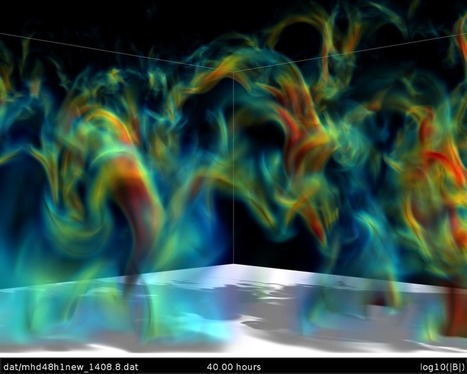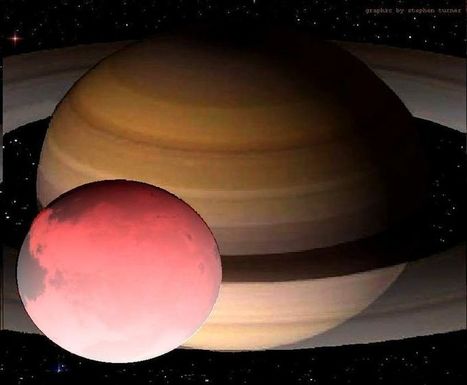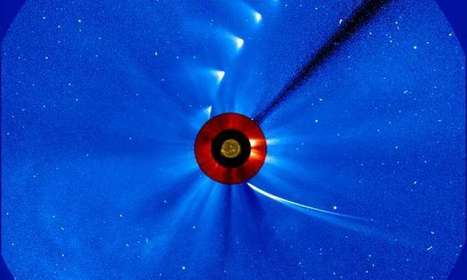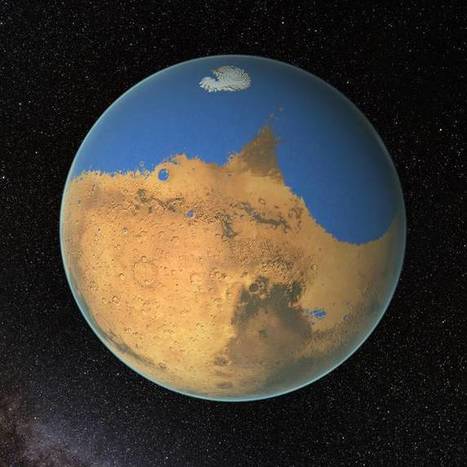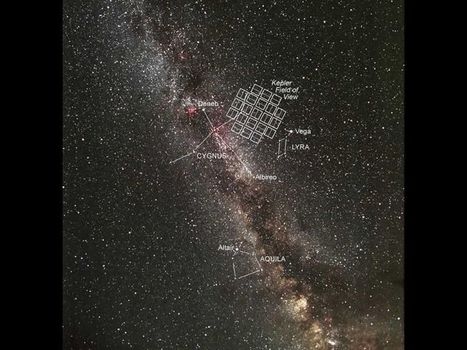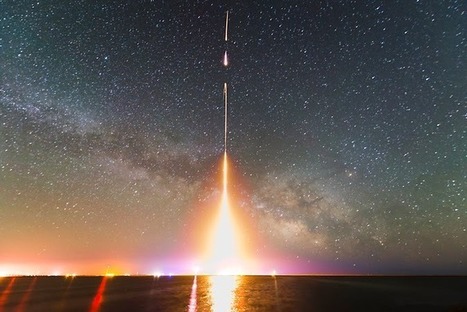 Your new post is loading...
 Your new post is loading...
"This is a challenging experiment because we're having to look through a foreground — namely, the Milky Way galaxy — that is at least four orders of magnitude brighter than the signal that we're trying to detect," said Jac
¡Radio Skylab expande sus archivos con la publicación del programa número 13! Tras la aprobación de las dos próximas misiones Discovery, hablamos de los diferentes programas de sondas de la NASA y de las misiones al Cinturón de Asteroides, Lucy y Psyche. Además, hablamos del trending topic #ElUniversoSeExpande y, por supuesto, de la expansión del Universo. Con los comentarios de los oyentes y nuevas recomendaciones. Víctor Manchado (Pirulo Cósmico), Daniel Marín (Eureka), Kavy Pazos (Mola Saber) y Víctor R. Ruiz (Infoastro) te invitamos a que nos acompañes a nuestros paseos por el espacio, la ciencia y otras curiosidades.
When astrobiologists contemplate life on nearby planets or moons, they often suggest such life would be simple. Instead of there being some kind of multicellular organism on, say, Jupiter’s moon Europa, scientists instead aim to find something more like a...
A lingering question surrounds the original source of the water that carried sediment into the Gale Crater Curiosity landing site (above). For flowing water to have existed on the surface, Mars must have had a thicker atmosphere and warmer climate...
Numerosas webs están erróneamente anunciando que un asteroide impactará contra la Tierra, en algún momento entre el 15 y el 28 de septiembre de 2015. Según estos rumores en dichas fechas habrá un impacto -"evidentemente" cerca de Puerto Rico- causando una terrible destrucción en el Atlántico y las costas de Estados Unidos y México que dan al Golfo, así como a Sudamérica y América Central. Este rumor se ha convertido en viral. Aquí están los hechos.
Según Paul Chodas, director de la Near-Earth Object office de la NASA en el Jet Propulsion Laboratory (Pasadena, California), "No hay base científica -ninguna evidencia- de que un asteroide o cualquier otro objeto celeste impactará en la Tierra en dichas fechas".
De hecho, el programa de la NASA de observación de objetos cercanos a la Tierra indica que no ha habido asteroides o cometas observados que podrían impactar en la Tierra en un futuro próximo. Todos asteroides potencialmente peligros conocidos tienen menos de un 0,01% de probabilidad de impactar contra la Tierra en los próximos 100 años.
Geoff Marcy remembers the hair standing up on the back of his neck. Paul Butler remembers being dead tired. The two men had just made history: the first confirmation of a planet orbiting another star. The groundbreaking discovery had been...
Planets having atmospheres rich in helium may be common in our galaxy, according to a new theory based on data from NASA's Spitzer Space Telescope.They wouldn't float like balloons or give you the chance to talk in high, squeaky voices,...
Magnetic reconnection could be the Universe's favorite way to make things explode. It operates anywhere magnetic fields pervade space--which is to say almost everywhere.
La NASA dibuja un océano con condiciones para la vida durante 1.500 millones de años.
Crédito: NASA/JPL-Caltech
Las imágenes de radar tomadas hoy del asteroide 2004 BL86 han revelado la presencia de una pequeña luna.
“In the quest for extraterrestrial biological signatures, the first stars we study should be white dwarfs,” said Avi Loeb, Director of Harvard University’s Institute for Theory and Computation .
NASA's New Horizons spacecraft comes out of hibernation for the last time on Dec. 6.
In 1960, the astronomer Francis Drake pointed a radio telescope located in Green Bank, West Virginia, toward two Sun-like stars 11 light years away. His hope: to pick up a signal that would prove intelligent life might be out there.
|
The Hubble Space Telescope has completely revolutionized our understanding of the universe, and has become a beloved icon of popular culture. Watch NASA's Amber Straughn provide an update on the progress of building the world’s largest-yet space telescope, th
“The Wide Field Infrared Survey Telescope (WFIRST) has the potential to open our eyes to the wonders of the universe, much the same way Hubble has,” said John Grunsfeld, astronaut and associate administrator of NASA’s Science Mission Directorate.
NASA's James Webb Space Telescope Webb telescope's images will reveal the first galaxies forming approximately 13.5 billion years ago. The telescope will also see through interstellar dust clouds to capture stars and planets forming in our own galaxy. At the...
Nearly all black holes come in one of two sizes: stellar mass black holes that weigh up to a few dozen times the mass of our sun or supermassive black holes ranging from a million to several billion times the...
A remote galaxy shining with the light of more than 300 trillion suns was discovered this past May using data from NASA's Wide-field Infrared Survey Explorer (WISE). The galaxy is the most luminous galaxy found to date and belongs to...
"SOHO has a view of about 12 and a half million miles beyond the sun," said Joe Gurman, the mission scientist for SOHO at NASA's Goddard Space Flight Center in Greenbelt, Maryland. "So we expected it might from time to time see a bright comet near the sun. But nobody dreamed we'd approach 200 a year." In 1995, a new solar observatory was launched. A joint project of ESA and NASA, the Solar and Heliospheric Observatory – SOHO – has been sending home images of our dynamic sun ever since. SOHO was planned to open up a new era of solar observations, dramatically extending our understanding of the star we live with. . . and it delivered.
But no one could have predicted SOHO's other observational triumph: In the last two decades, SOHO has become the greatest comet finder of all time. In August 2015, SOHO is expected to discover its 3000th comet. Prior to the SOHO launch, only a dozen or so comets had ever even been discovered from space, and some 900 had been discovered from the ground since 1761.
As NASA missions explore our solar system and search for new worlds, they are finding water in surprising places. Water is but one piece of our search for habitable planets and life beyond Earth, yet it links many seemingly unrelated worlds in surprising ways.
"NASA science activities have provided a wave of amazing findings related to water in recent years that inspire us to continue investigating our origins and the fascinating possibilities for other worlds, and life, in the universe," said Ellen Stofan, chief scientist for the agency. "In our lifetime, we may very well finally answer whether we are alone in the solar system and beyond."
The chemical elements in water, hydrogen and oxygen, are some of the most abundant elements in the universe. Astronomers see the signature of water in giant molecular clouds between the stars, in disks of material that represent newborn planetary systems, and in the atmospheres of giant planets orbiting other stars.
A primitive ocean on Mars held more water than Earth’s Arctic Ocean, according to NASA scientists who, using ground-based observatories, measured water signatures in the Red Planet’s atmosphere.
A team of 21st-century explorers working for the Hunt for Exomoons with Kepler (HEK) project, based at Harvard University, are searching for exomoons using data from NASA’s Kepler mission and the Pleiades supercomputer at the NASA Advanced...
"Like a phoenix rising from the ashes, Kepler has been reborn and is continuing to make discoveries. Even better, the planet it found is ripe for follow-up studies," says Andrew Vanderburg of the Harvard-Smithsonian Center for Astrophysics (CfA). The report of the Kepler spacecraft's death was greatly exaggerated. Despite a malfunction that ended its primary mission in May 2013, Kepler is still alive and working. The evidence comes from the discovery of a new super-Earth using data collected during Kepler's "second life." NASA's Kepler spacecraft detects planets by looking for transits, when a star dims slightly as a planet crosses in front of it. The smaller the planet, the weaker the dimming, so brightness measurements must be exquisitely precise. To enable that precision, the spacecraft must maintain a steady pointing.
Kepler's primary mission came to an end when the second of four reaction wheels used to stabilize the spacecraft failed. Without at least three functioning reaction wheels, Kepler couldn't be pointed accurately.
Rather than giving up on the plucky spacecraft, a team of scientists and engineers developed an ingenious strategy to use pressure from sunlight as a virtual reaction wheel to help control the spacecraft. The resulting second mission, K2, promises to not only continue Kepler's search for other worlds, but also introduce new opportunities to observe star clusters, active galaxies, and supernovae.
Imagen de lanzamiento de CIBER en 2013 desde las instalaciones de la NASA en Wallops, Virginia. Imagen, Crédito: T.
NASA's Cassini mission continues its adventures in extraterrestrial oceanography with new findings about the hydrocarbon seas on Saturn's moon Titan.
|

 Your new post is loading...
Your new post is loading...
 Your new post is loading...
Your new post is loading...










